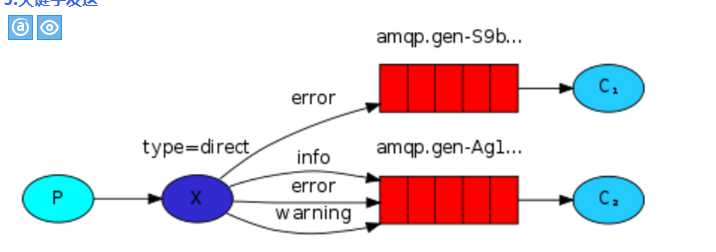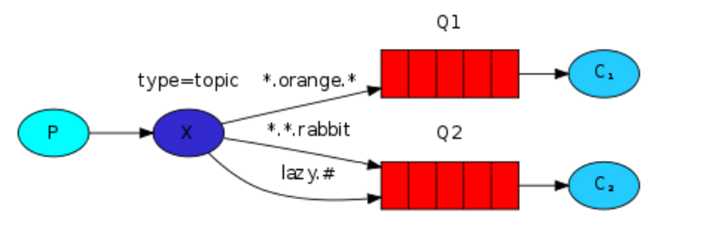标签:
安装配置epel源 # rpm -ivh http://dl.fedoraproject.org/pub/epel/6/i386/epel-release-6-8.noarch.rpm 安装erlang # yum -y install erlang 安装RabbitMQ # yum -y install rabbitmq-serverservice rabbitmq-server start/stop 注意:需要关闭防火墙和selinux # systemctl stop firewalld.service # setenforce 0
# apt-get install build-essential # apt-get install libncurses5-dev # apt-get install libssl-dev # apt-get install erlang 编辑 /etc/apt/sources.list 加入 deb http://www.rabbitmq.com/debian/ testing main # wget -O- https://www.rabbitmq.com/rabbitmq-release-signing-key.asc | apt-key add - # apt-get update # apt-get install rabbitmq-server
首先是到ERLang官网去下载ERlang 地址:http://www.erlang.org/download.html 然后安装ERLang。 然后设置ERLang的环境变量。 在环境变量中加入 ERL_HOME = erlang安装目录 在path中添加 %ERL_HOME%\bin 然后从http://www.rabbitmq.com/releases/rabbitmq-server/v3.1.5/rabbitmq-server-3.1.5.exe下载rabbitmq-server 并安装。 然后从 开始菜单中找到 rabbitmq-start 打开 此刻rabbitmq-server就启动了
pip install pika or easy_install pika
#!/usr/bin/env python3
#coding:utf8
import queue
import threading
message = queue.Queue(10)
def producer(i):
‘‘‘厨师,生产包子放入队列‘‘‘
while True:
message.put(i)
print("%s放入队列%s" % (threading.current_thread().name, i))
def consumer(i):
‘‘‘消费者,从队列中取包子吃‘‘‘
while True:
msg = message.get()
print("%s从队列总取出%s" % (threading.current_thread().name, msg))
if __name__ == ‘__main__‘:
for i in range(12): # 厨师的线程包子
t = threading.Thread(target=producer, args=(i,))
t.start()
for i in range(10): # 消费者的线程吃包子
t = threading.Thread(target=consumer, args=(i,))
t.start()
#!/usr/bin/env python 3
import pika
######### 生产者 #########
#链接rabbit服务器(localhost是本机,如果是其他服务器请修改为ip地址)
connection = pika.BlockingConnection(pika.ConnectionParameters(host=‘localhost‘))
#创建频道
channel = connection.channel()
#创建一个队列名叫test
channel.queue_declare(queue=‘test‘)
# channel.basic_publish向队列中发送信息
# exchange -- 它使我们能够确切地指定消息应该到哪个队列去。
# routing_key 指定向哪个队列中发送消息
# body是要插入的内容, 字符串格式
while True: # 循环向队列中发送信息,quit退出程序
inp = input(">>>").strip()
if inp == ‘quit‘:
break
channel.basic_publish(exchange=‘‘,
routing_key=‘test‘,
body=inp)
print("生产者向队列发送信息%s" % inp)
#缓冲区已经flush而且消息已经确认发送到了RabbitMQ中,关闭链接
connection.close()
# 输出结果
>>>python
生产者向队列发送信息python
>>>quit
#!/usr/bin/env python 3
import pika
######### 消费者 #########
# 链接rabbit
connection = pika.BlockingConnection(pika.ConnectionParameters(host=‘localhost‘))
# 创建频道
channel = connection.channel()
# 如果生产者没有运行创建队列,那么消费者也许就找不到队列了。为了避免这个问题,所有消费者也创建这个队列,如果队列已经存在,则这条无效
channel.queue_declare(queue=‘test‘)
#接收消息需要使用callback这个函数来接收,他会被pika库来调用,接受到的数据都是字节类型的
def callback(ch, method, properties, body):
"""
ch : 代表 channel
method :队列名
properties : 连接rabbitmq时设置的属性
body : 从队列中取到的内容,获取到的数据时字节类型
"""
print(" [x] Received %r" % body)
# channel.basic_consume 表示从队列中取数据,如果拿到数据 那么将执行callback函数,callback是回调函数
# no_ack=True 表示消费完这个消息以后不主动把完成状态通知rabbitmq
channel.basic_consume(callback,
queue=‘test‘,
no_ack=True)
print(‘ [*] 等待信息. To exit press CTRL+C‘)
#永远循环等待数据处理和callback处理的数据,start_consuming方法会阻塞循环执行
channel.start_consuming()
# 输出结果,一直等待处理队列中的消息,不知终止,除非人为ctrl+c
[*]等待消息,To exit press CTRL+C
[x] Received b‘python‘
import pika
import time
# 链接rabbit
connection = pika.BlockingConnection(pika.ConnectionParameters(host=‘localhost‘))
# 创建频道
channel = connection.channel()
# 如果生产者没有运行创建队列,那么消费者创建队列,如果队列已存在,创建队列操作会被忽略
channel.queue_declare(queue=‘hello‘)
# 回调函数
def callback(ch, method, properties, body):
print(" [x] Received %r" % body)
time.sleep(10)
print(‘ok‘ )
ch.basic_ack(delivery_tag = method.delivery_tag) # 当上面消息处理完成后,通知rabbitmq,消息处理完成,不要在发送了
channel.basic_consume(callback,
queue=‘hello‘,
no_ack=False) # 表示消费完这个消息后,主动通知rabbitmq完成状态,如果不通知,rabbitmq会把这条消息重新放回队列中,避免丢失
print(‘ [*] Waiting for messages. To exit press CTRL+C‘)
channel.start_consuming()
当生产者生成一条数据,被消费者接收,消费者中断后如果不超过10秒,连接的时候数据还在。当超过10秒后,重新连接,数据将消失。消费者等待连接。
这个queue_declare 需要在 生产者(product)和消费者(consumer)代码中都进行设置。
#!/usr/bin/env python
import pika
# 链接rabbit服务器
connection = pika.BlockingConnection(pika.ConnectionParameters(host=‘localhost‘))
# 创建频道
channel = connection.channel()
# 创建队列,使用durable方法
channel.queue_declare(queue=‘test‘, durable=True)
# 如果想让队列实现持久化那么加上durable=True
channel.basic_publish(exchange=‘‘,
routing_key=‘test‘,
body=‘Hello World!‘,
properties=pika.BasicProperties(
delivery_mode=2,
# 标记我们的消息为持久化的 - 通过设置 delivery_mode 属性为 2,在生产者端持久化
))
# 这个exchange参数就是这个exchange的名字. 空字符串标识默认的或者匿名的exchange:如果存在routing_key, 消息路由到routing_key指定的队列中。
print(" [x] 开始队列‘")
connection.close()
#!/usr/bin/env python
# -*- coding:utf-8 -*-
import pika
connection = pika.BlockingConnection(pika.ConnectionParameters(host=‘localhost‘))
# 创建频道
channel = connection.channel()
# 创建队列,使用durable方法,durable=True 开启持久化
channel.queue_declare(queue=‘test‘, durable=True)
def callback(ch, method, properties, body):
print(" [x] Received %r" % body)
import time
time.sleep(10)
print(‘ok‘)
ch.basic_ack(delivery_tag = method.delivery_tag)
channel.basic_consume(callback,
queue=‘hello‘,
no_ack=False)
print(‘ [*] 等待队列. To exit press CTRL+C‘)
channel.start_consuming()
备注:标记消息为持久化的并不能完全保证消息不会丢失,尽管告诉RabbitMQ保存消息到磁盘,当RabbitMQ接收到消息还没有保存的时候仍然有一个短暂的时间窗口,RabbitMQ不会对每个消息都执行同步fsync(2),可能只是保存到缓存cache还没有写入到磁盘中,这个持久化保证不是很强,但这比我们简单的任务queue要好得多,如果你想要很稳定的消息不丢失,可以使用publisher confirms。
默认消息队列里的数据是按照顺序被消费者拿走,例如,消费者1去队列中获取奇数序列任务(分别取任务1,3,5,7),消费者2去队列中获取偶数序列任务(分别取任务2,4,6,8)。如果消费者1处理的任务速度很快,当他完成1,3任务后,消费者2可能2任务还没有处理完,但是消费者1会继续按照排序去取第5个任务而不是第4个任务,完成第五个任务,在执行第七个任务。为了改变这种默认的取任务排序,需要改变参数channel.basic_qos(prefetch_count=1)表示谁来谁取,不在按照奇偶数排列。
#!/usr/bin/env python3
# -*- coding:utf-8 -*-
import pika
import sys
connection = pika.BlockingConnection(pika.ConnectionParameters(host=‘localhost‘))
channel = connection.channel()
# 设置队列为持久化的队列
channel.queue_declare(queue=‘task_queue‘, durable=True)
message = ‘ ‘.join(sys.argv[1:]) or "Hello World!"
channel.basic_publish(exchange=‘‘,
routing_key=‘task_queue‘,
body=message,
properties=pika.BasicProperties(
delivery_mode = 2, # 设置消息为持久化的
))
print(" [x] Sent %r" % message)
connection.close()
#!/usr/bin/env python 3
# -*- coding:utf-8 -*-
import pika
import time
connection = pika.BlockingConnection(pika.ConnectionParameters(host=‘localhost‘))
channel = connection.channel()
channel.queue_declare(queue=‘task_queue‘,durable=True) # 设置队列持久化
def callback(ch, method, properties, body):
print(" [x] Received %r" % body)
time.sleep(10)
print(‘ok‘)
ch.basic_ack(delivery_tag = method.delivery_tag)
channel.basic_qos(prefetch_count=1) # 表示谁来谁取,不在按照奇偶数排序
channel.basic_consume(callback,
queue=‘task_queue‘,
no_ack=False)
print(‘ [*] Waiting for messages. To exit press CTRL+C‘)
channel.start_consuming()

发布订阅和简单的消息队列区别在于,发布订阅会将消息发送给所有的订阅者,而消息队列中的数据被消费一次便消失了。所以,RabbitMQ实现发布和订阅时,会为每一个订阅者创建一个队列,二发布者发布消息时,会将消息放置在所有相关队列中。发布订阅本质上就是发布端将消息发送给了exchange,exchange将消息发送给与它绑定关系的所有队列。
exchange type = fanout 和exchange绑定关系的所有队列都会收到信息
#!/usr/bin/env python3
import pika
import sys
connection = pika.BlockingConnection(pika.ConnectionParameters(host=‘localhost‘))
channel = connection.channel()
channel.exchange_declare(exchange=‘logs‘, type=‘fanout‘) # 创建了一个exchange名字叫logs,type=fanout。有了exchange,我们就不需要去创建队列了
message = ‘ ‘.join(sys.argv[1:]) or "info: Hello World!"
channel.basic_publish(exchange=‘logs‘, routing_key=‘‘, body=message) # 指定了exchange后,就不需要指定队列了,所有routing_key=‘‘
print(" [x] Sent %r" % message)
connection.close()
#!/usr/bin/env python3
import pika
connection = pika.BlockingConnection(pika.ConnectionParameters(host=‘localhost‘))
channel = connection.channel()
channel.exchange_declare(exchange=‘logs‘, type=‘fanout‘) # 创建exchange
result = channel.queue_declare(exclusive=True) # 不指定queue名字,随机生成一个唯一的queue,队列断开后自动删除临时队列
queue_name = result.method.queue # 队列名采用服务端分配的临时队列
channel.queue_bind(exchange=‘logs‘, queue=queue_name) # 将临时队列和exchange绑定
print(‘ [*] Waiting for logs. To exit press CTRL+C‘)
def callback(ch, method, properties, body): # 回调方法
print(" [x] %r" % body)
channel.basic_consume(callback, queue=queue_name, no_ack=True) # 消息接收
channel.start_consuming() # 保持一直监听的状态

#!/usr/bin/env python3
#coding:utf8
#######################生产者#################
import pika
import sys
connection = pika.BlockingConnection(pika.ConnectionParameters(host=‘localhost‘))
channel = connection.channel()
channel.exchange_declare(exchange=‘direct_logs‘, type=‘direct‘)
severity = sys.argv[1] if len(sys.argv) > 1 else ‘info‘
message = ‘ ‘.join(sys.argv[2:]) or ‘Hello World!‘
channel.basic_publish(exchange=‘direct_logs‘,
routing_key=severity,
body=message)
print(" [x] Sent %r:%r" % (severity, message))
connection.close()
#!/usr/bin/env python3
#coding:utf8
import pika
import sys
############消费者####
# 连接
connection = pika.BlockingConnection(pika.ConnectionParameters(host=‘localhost‘))
channel = connection.channel()
channel.exchange_declare(exchange=‘direct_logs‘, type=‘direct‘)
result = channel.queue_declare(exclusive=True)
queue_name = result.method.queue
# serverites 是一个列表,存放关键字,关键字是通过sys.argv获取的
severities = sys.argv[1:]
if not severities:
sys.stderr.write("Usage: %s [info] [warning] [error]\n" % sys.argv[0])
sys.exit(1)
# 循环绑定关键字和exchange
for severity in severities:
channel.queue_bind(exchange=‘direct_logs‘,
queue=queue_name,
routing_key=severity)
print(‘ [*] Waiting for logs. To exit press CTRL+C‘)
def callback(ch, method, properties, body):
print(" [x] %r:%r" % (method.routing_key, body))
channel.basic_consume(callback,
queue=queue_name,
no_ack=True)
channel.start_consuming()

#!/usr/bin/env python3
#coding:utf8
import pika
import sys
connection = pika.BlockingConnection(pika.ConnectionParameters(host=‘localhost‘))
channel = connection.channel()
channel.exchange_declare(exchange=‘topic_logs‘,type=‘topic‘)
result = channel.queue_declare(exclusive=True)
queue_name = result.method.queue
binding_keys = sys.argv[1:]
if not binding_keys:
sys.stderr.write("Usage: %s [binding_key]...\n" % sys.argv[0])
sys.exit(1)
for binding_key in binding_keys:
channel.queue_bind(exchange=‘topic_logs‘,
queue=queue_name,
routing_key=binding_key)
print(‘ [*] Waiting for logs. To exit press CTRL+C‘)
def callback(ch, method, properties, body):
print(" [x] %r:%r" % (method.routing_key, body))
channel.basic_consume(callback,
queue=queue_name,
no_ack=True)
channel.start_consuming()
#!/usr/bin/env python3
#coding:utf8
import pika
import sys
connection = pika.BlockingConnection(pika.ConnectionParameters(host=‘localhost‘))
channel = connection.channel()
channel.exchange_declare(exchange=‘topic_logs‘, type=‘topic‘)
routing_key = sys.argv[1] if len(sys.argv) > 1 else ‘anonymous.info‘
message = ‘ ‘.join(sys.argv[2:]) or ‘Hello World!‘
channel.basic_publish(exchange=‘topic_logs‘,
routing_key=routing_key,
body=message)
print(" [x] Sent %r:%r" % (routing_key, message))
connection.close()
标签:
原文地址:http://www.cnblogs.com/wang-yc/p/5720271.html